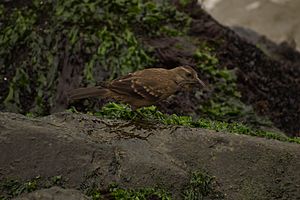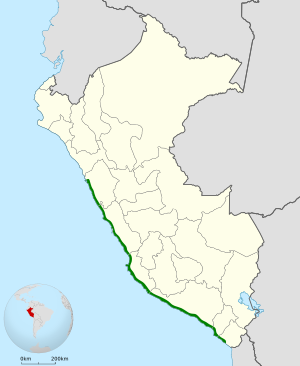Peruvian seaside cinclodes facts for kids
Quick facts for kids Peruvian seaside cinclodes |
|
|---|---|
 |
|
| Conservation status | |
| Scientific classification | |
| Genus: |
Cinclodes
|
| Species: |
taczanowskii
|
 |
|
The Peruvian seaside cinclodes (pronounced: sink-LOH-deez) is a small bird. It is also called the surf cinclodes. This bird lives only on the rocky coastlines of Peru. It is part of the Furnariidae family, which includes many birds from Central and South America. Some scientists think this bird might be a type of the Chilean seaside cinclodes.
Contents
What is the Peruvian Seaside Cinclodes?
This bird is a type of bird that is unique to Peru. It was first described in 1892 by scientists Hans von Berlepsch and Jean Stanislaus Stolzmann. The Peruvian seaside cinclodes is well-adapted to its coastal home. It spends its life near the ocean waves.
Where Does This Bird Live?
The Peruvian seaside cinclodes lives only along the rocky shores of Peru. It can be found from the northern parts of Peru down to the southern coast. These birds prefer areas with rocks and cliffs near the water. They are often seen close to the surf, looking for food.
What Does It Look Like?
The Peruvian seaside cinclodes is a small bird. It has feathers that help it blend in with the rocks. This helps it hide from predators. It has a strong beak that is good for finding food in cracks and crevices. Its feet are also strong, helping it grip onto slippery rocks.
What Does the Surf Cinclodes Eat?
This bird mainly eats small creatures found along the coast. It looks for insects, tiny crabs, and other small invertebrates. It uses its beak to poke around in the sand and under rocks. It also catches food in the water near the shoreline. This bird is very good at finding food in its ocean home.
Life Cycle and Behavior
The Peruvian seaside cinclodes builds its nests in safe places. It often chooses cracks in rocks or small caves along the cliffs. This keeps its eggs and chicks safe from predators and the ocean waves.
How Do They Reproduce?
Female cinclodes lay their eggs in the nest. Both parents help to care for the eggs and the young chicks. They bring food back to the nest until the chicks are old enough to fly. The young birds learn to find food on their own. They also learn to live safely along the coast.
How Do They Behave?
These birds are often seen alone or in small groups. They are very active, always moving and searching for food. They can be quite shy, but if you are quiet, you might see them hopping along the rocks. Their calls are simple and help them communicate with each other.
Conservation Status
The Peruvian seaside cinclodes is listed as "Least Concern" by the IUCN. This means that its population is currently stable. However, it is important to protect its coastal habitat. Pollution and human activity can affect these birds. Protecting their homes helps them continue to thrive.
See also
 In Spanish: Remolinera costera peruana para niños
In Spanish: Remolinera costera peruana para niños


